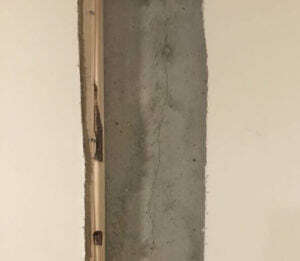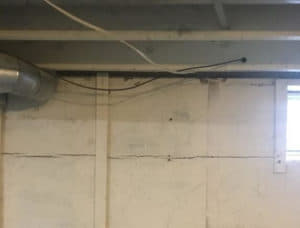
Originally posted 3/22/19, updated 8/23/21
If you have a crack in your foundation, you’re probably a little panicked right now. After all, your entire house is resting on that foundation! What if that crack splits wide open? Will your home start to slide? Will the wall above the foundation crack open, too? Before you work yourself up and start shouting that the sky is falling, let’s take a deep breath and back away from the panic button.
Your home wasn’t built in one night, it’s typically not going to collapse in a single day. (Think I’m being melodramatic, and people don’t worry about these things? You’d be surprised.)
Acculevel is a family-owned and operated company that specializes in foundation repair, and basement work - including basement waterproofing in Des Moines, IA, and other areas. Since our start in 1996, we’ve helped more than 30,000 Midwestern homeowners restore strength, stability, and resale value to their homes, while also regaining their peace of mind.
We want to help you understand what causes foundation cracks, what the repair options are, why we don’t recommend the injection method, and why you should not attempt to DIY foundation repairs.
There are two main forces that cause foundation cracks: settling and hydrostatic pressure. If your foundation is settling, you’re going to need something other than caulking, crack injections or epoxy fills.
There are three major signs your foundation is settling unevenly:
All these things happen because the ground below your foundation has eroded or moved. When one section of your foundation sinks more than the others, it strains the materials that make up your home. None of the materials (concrete, wood, drywall) flex or bend; instead, wooden frames twist, and concrete cracks.
Foundation cracks that are caused by settling will need to be fixed, but first you have to stop the foundation from sinking any more than it has. Settling foundation cracks require helical piers.
Water and water pressure can also create cracks in your foundation, and these are the ones that we’re addressing in this article.
Hydrostatic pressure occurs when there is more water in the ground than the soil can absorb. The combination of saturated soil and excess water pushes against your foundation. This pressure makes your foundation function like a dam- except that isn’t what it’s designed to do.
Your foundation is designed to support your house: it’s structured to resist pressure from above. It is not designed to resist pressure coming from the side. If there’s enough water creating the crack, or seeping into the concrete, those cracks may also let water into your basement or crawl space.
 This photo was taken by an Acculevel project advisor, during a free estimate appointment. This crack allowed water to get into the basement, soaking the drywall.
This photo was taken by an Acculevel project advisor, during a free estimate appointment. This crack allowed water to get into the basement, soaking the drywall.
You ignore foundation cracks at your own risk. First, because they can become a point of water intrusion. But second- and this is critical- they represent a weak spot in your foundation. Cracks caused by hydrostatic pressure will spread; they will become longer and wider, and will eventually be a threat to your home’s stability.
 This photo was taken by an Acculevel project advisor during a free estimate appointment. The long horizontal crack was caused by hydrostatic pressure.
This photo was taken by an Acculevel project advisor during a free estimate appointment. The long horizontal crack was caused by hydrostatic pressure.
In the above picture, you can see the long horizontal crack that has formed. As water continues to put pressure on that wall, the crack will widen. Not only is it going to let in water, it’s also going to start bowing inward. We break down the types of cracks that form, and how dangerous they are, in this article.
Before you can fill the crack, you have to insert ports into the crack. These ports will be placed every 6-12 inches, wedged into place. The injection tool will push the crack fill through the port into the crack, until the next port is reached. The “full” port will be capped to close it, and they move on to the next one. This process is repeated until the crack is filled.
The ports cannot be removed until the crack fill material has completely dried. This may take a few days, up to a week, depending on the humidity in the space.
Acculevel did, at one time, use the injection method to repair cracks. However, our experience with this process was unsatisfactory. Ports interfered with the fill process, making it harder to gauge how much fill material was in place, and if it was a sufficient amount.
Ports also leave holes in the concrete, which we find counterproductive. And most important of all: port injection repairs did not work as well or last as long as we believed they should.
Instead, Acculevel uses the epoxy fill method. We are much more confident in this process, and warranty our crack repairs for 5 years. You can learn more about our epoxy method and its results here.
It may be tempting, especially if you are a DIY homeowner, to repair the foundation cracks yourself. We strongly urge you not to do this. Caulking a bathtub is a very different process than filling a foundation crack.
Our project advisors are trained to evaluate and assess the cracks in your foundation. They can determine the cause of your foundation damage, and recommend the ideal whole-home solution that will protect and preserve your home.
We firmly believe our crews are the best in the industry; most of our crew leaders have been with us for 10+ years. In addition to all this experience and expertise? The materials we use are not available to the general public. Any fill kit or epoxy that you find in a big box store is going to be less effective, and won’t carry a service warranty to provide peace of mind.
If you have more questions about crack repairs, settling issues, bowing walls, or other potential foundation problems, check out our free comprehensive Foundation Repair Guide for Homeowners. This guide is regularly updated, and meant to be a resource for everyone who has questions about symptoms they’ve seen or experienced in their homes.
Contact Acculevel at 866-669-3349, or by completing our online form. We’ll schedule an appointment for you, at your convenience, to meet with one of our project advisors. They’ll meet you on-time, at your home, and discuss your concerns. Then, they’ll evaluate your home and foundation, diagnose what problems you have (if any), and work with you to determine the optimal solution for you and your home.
Our service area covers Indiana and parts of the surrounding states; we have recently expanded coverage to now include the Cincinnati OH area!
If you live outside of our service area, please verify that the contractor you hire is insured and accredited by the Better Business Bureau. Not sure how to find a contractor? Check with friends or neighbors who may have had similar issues, or check with your HOA or local realtor. Both often have lists of dependable contractors they call on for help.
[DISPLAY_ULTIMATE_SOCIAL_ICONS]